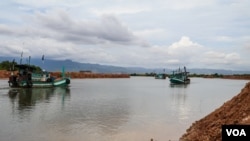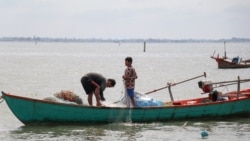Fisherman Mert Youb doesn’t want his teenage son to make his living at sea.
“I want him to study and become a teacher or do other work, because I think fishing at sea could be really risky in the future. I don’t want him to be like me,” Mert Youb told VOA Khmer in early October.
“Last month, there was a boat that sank due to strong wind, but the fisherman was rescued on time,” added the 41-year-old fisherman.
Climate change is bringing more storms and strong winds to Mert Youb’s coastal community, making life even tougher for fishers already facing smaller catches due to illegal fishing practices and unchecked development ravaging the seascape.
These days, Mert Youb’s daily haul of shrimp, crabs, octopus and small fish is about equal to what he used to catch in shrimp alone — though higher prices mean he still brings in about $22.50 for a 12-hour day.
Global experts say one major effect of global warming — more frequent and intense severe weather — will be felt most in developing countries where people rely on fishing for income and sustenance.
One NASA study from late 2018 "supports the notion that global warming is causing the number of extreme storms to increase, at least over Earth’s tropical oceans (between 30 degrees North and South of the equator)." Cambodia is between 10 and 14 degrees latitude north of the equator.
That’s already playing out in coastal zones in Cambodia, where sea levels are slowly rising and storms are adding a new element of danger to an already hardscrabble way of life.
According to a 2021 World Bank report, “Climate Risk Country Profile” for Cambodia, the country’s coastal zones “are known to hold exposure to cyclone and tsunami-induced storm surge, albeit at lower levels than a number of other Southeast Asian nations.”
“Without adaptation sea-level rise is likely to increase the overall risk faced by the agricultural communities in the country’s southwestern region,” the report said. Also, “The impacts of sea-level rise in Cambodia are understudied.”
Les Kert, 48, another fisherman, said his teenage son dropped out of school during the COVID-19 pandemic and now works on a fishing boat, earning about $7.50 to $10 a day.
“If there is rain or wind, it can put our lives at risk,” Les Kert said. “My wife always cries when we meet strong wind.”
Both Mert Youb and Les Kert said rapid development of the coastline and illegal fishing practices like electrified nets and industrial-scale trawling — often by Vietnamese boats crossing into Cambodian waters — were largely to blame for their troubles. But erratic weather and increasing temperatures are compounding their struggles.
“The weather has changed completely. In the past, we had the same strong wind, but it occurs predictably. But now it can happen at any time,” said Mert Youb.
And they both worry about what it means for the next generation. “If we lose places to fish, what can they hope for?” said Mert Youb. “In the future, they can only work as laborer for others since they can’t fish at sea,” said Les Kert.
All of Cambodia is “highly vulnerable” to climate change because so many people are barely scraping by and there are limited government resources to help them, according to reports from the United Nations and the Cambodian government.
However, few areas are feeling the effects as strongly as the areas along Cambodia’s 450-kilometer coastline, where agriculture, fishing, tourism and shipping are all vulnerable.
Cambodia’s sea level could rise by more than half a meter by 2090, inundating 25,000 hectares and forcing thousands to relocate, according to the government’s 2013 Climate Change Strategic Plan. Temperatures are expected to rise by between 0.13 and 0.36 degrees Celsius per decade.
According to a study on public perceptions of climate change in Cambodia, “Understanding Public Perception of Climate Change in Cambodia: Knowledge, Attitudes, and Practices in Cambodia,” published earlier this year, people in coastal regions are “particularly vulnerable to the impacts of climate change.” And yet coastal residents were also “the most likely to say that they did not know how to take action,” the report said, citing lower income and education levels as a possible explanation.
Sim Him, chief of Trapeang Sangkae fishery community, which has been turned into an ecotourism site, said recent storms knocked down 300 homes in the area. And the rising temperature is reducing fish production, he added.
But the biggest threat to his community, which revolves around its mangrove forests, is the creeping development. “If there is more and more encroachment, our community will be ruined,” said Sim Him. As of now, it is unclear whether the development will be residential, commercial or mixed use.
Mov Chheang, the Trapeang Sangkae commune chief, said the number of fishing families has decreased, as local people go to work on construction sites or in factories. Some of those jobs are elsewhere in the province. Others are in Cambodia’s big cities.
Hak Mao, director of the Department of Climate Change of the Environment Ministry, said the Cambodian government wasn’t keeping data on the current conditions along the coast. “We just know that wind is more serious now since it is frequent,” he said.
For fisherman Les Nos, 37, it’s the unpredictability — of the weather, his daily catch and his income — that has him on edge. Every day he heads out on his motorboat at 5 a.m. and returns home to his fishing community in Kampot province at 10 or 11 p.m.
“Some days, I can catch around 5 to 7 kilograms per day. And sometimes, I can catch only a few kilograms of fish,” Les Nos said.
And he only sees things getting more dire, saying, “I am concerned as the weather becomes worse and worse, I won’t be able to fish since there are big storms and waves.”









